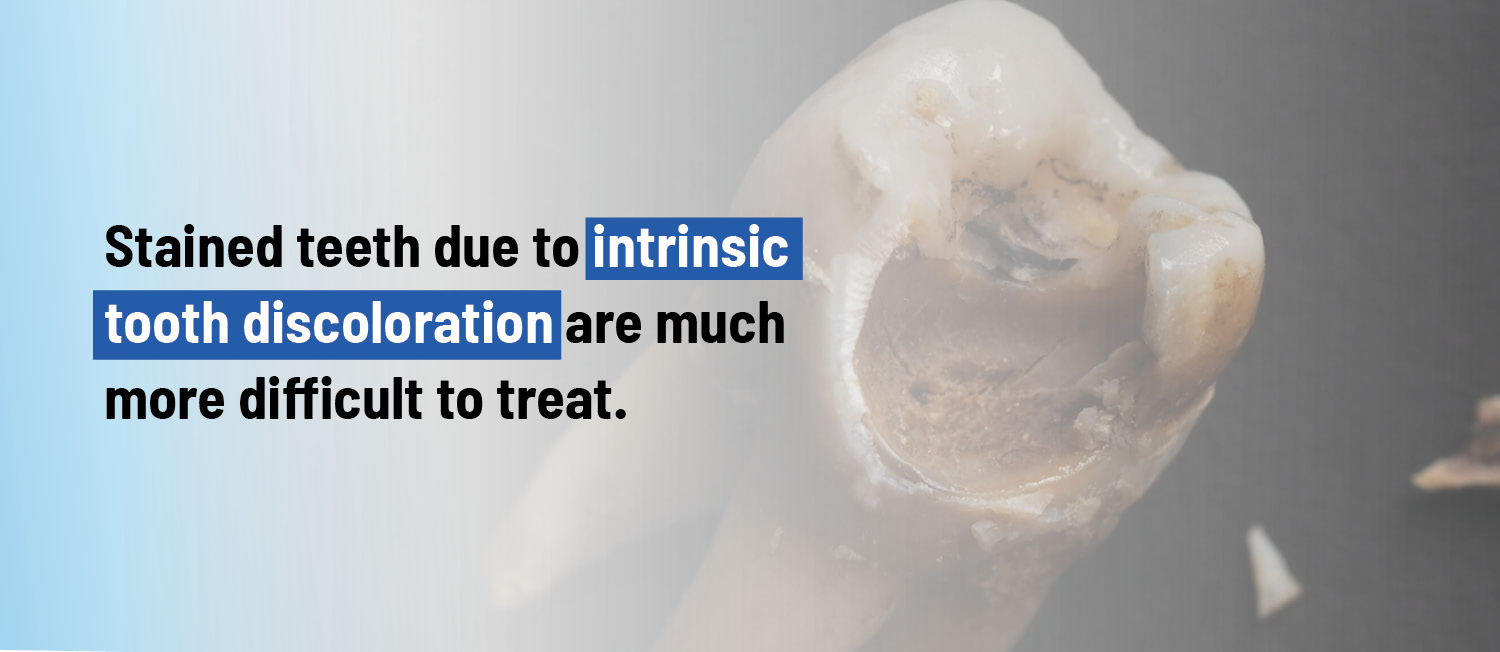Teeth whitening is one of the most popular methods people use to improve their confidence. According to a survey by Mintel/Greenfield Online, 67% of American adults have tried to whiten their teeth in one way or another. Many methods of teeth whitening are relatively inexpensive and easy to use. Unfortunately, they don’t always result in the perfect, white shade that people expect.
Many people are left wondering what to do when their teeth whitening method doesn’t work. Will other methods work? Which method will get the job done? Is there an underlying issue? Here, we will go over what kinds of stains are harder to remove and how to get better results.
Types of Tooth Discoloration
Tooth staining comes in varying degrees of severity, making it harder to combat all stains with the same kinds of treatments.
Extrinsic Tooth Discoloration
Extrinsic tooth discoloration only affects the enamel, or outer layer, of the tooth. These kinds of stains are typically caused by external factors like smoking, or drinking coffee, tea, or wine. Generally, brushing won’t remove these stains. Some home whitening methods might be effective for extrinsic tooth discoloration, but for stains that are deeper set into the enamel, professional whitening might be necessary.
Intrinsic Tooth Discoloration
Intrinsic tooth discoloration occurs in the dentin layer of the teeth, which is underneath the enamel layer. This type of discoloration usually appears as a yellowing of the teeth and can happen from trauma to a tooth or from certain types of medications. An antibiotic called tetracycline is often associated with tooth discoloration, along with some antihistamines, blood pressure medications, and chemotherapy. Stained teeth due to intrinsic tooth discoloration are much more difficult to treat.
Reasons Why Teeth Whitening Isn’t Working
In general, teeth whitening won’t work if the stains go deeper than the chosen whitening method can penetrate. Several methods of teeth whitening that are available for home use only clean or bleach the surface of the teeth. Even some professional whitening methods won’t reach the deepest stains. Some other reasons teeth whitening might not work are:
- Low Bleaching Strength – The strength of home bleaching kits can vary. It might be helpful to check the strength of the active ingredients and try something stronger.
- Genetics – Genetics can cause some teeth to have a darker color naturally and to be more resistant to whitening.
- Dental Restorations – Restorative dental work, like crowns, areas with dental bonding, and fillings, won’t respond to teeth whitening treatments in the same way as natural enamel.
- Poor Oral Health – Gum disease and tooth decay can affect how well teeth whitening works. It is best to keep up with regular dental check-ups and cleanings and to address any underlying issues before trying to whiten teeth.
- Poor Contact with Whitening Agents – For whitening products to be effective, they need to be in contact with the enamel of the teeth. If teeth are not properly cleaned before use or the whitening strips or trays are not applied correctly, the products might not work.

Stronger Teeth Whitening Methods and Alternatives
Whatever the cause, some people simply cannot get the results they are looking for with home whitening products. If this is the case, it is best to talk to a dentist about professional whitening methods for stubborn stains on teeth. A dentist can determine if these methods would be helpful or if other alternatives might be needed. Below are some methods dentists use for whitening teeth.
Professional Gel Whitening
Many dentists offer various kinds of whitening that involve administering a gel to the teeth. These are similar to at-home kits that can be bought online or at the store. However, dentists use whitening gels with much stronger active ingredients, which is generally some form of hydrogen peroxide. While at-home kits usually have a strength of less than 20%, the gels dentists use contain up to 43% of the active ingredient.
Some professional whitening is done with a gel alone and others are activated by equipment using lasers or ultraviolet light. The process is relatively quick and painless but can cause some sensitivity.
Microabrasion
Microabrasion is a teeth whitening method in which a dentist uses a tool to remove an extremely thin layer of enamel to reveal a whiter layer underneath. This method is effective for removing certain types of surface stains, including tooth discoloration from excessive fluoride exposure during tooth development.
Dental Bonding
When yellow or stained teeth don’t respond to whitening methods, a dentist might recommend dental bonding. Dental bonding is often used for fixing chipped teeth, closing gaps, or reshaping teeth, but it can also be used to cover stains. This technique uses a tooth colored resin that is applied over a discolored tooth or teeth.
Veneers
Veneers are another option for covering up stained teeth. Veneers are shell-like covers made from porcelain or composite resin that are adhered to the teeth. The downside for veneers is their high price compared to other whitening alternatives and the permanent alteration of the underlying teeth. However, some veneers, called Lumineers, can be applied without damaging the original tooth. Candidates for any veneers should have healthy teeth without decay.
Crowns
In cases where there is severe decay or the teeth are weakened, a dentist might recommend dental crowns. During the procedure for a crown, the tooth is filed down and then a tooth colored cap is placed over the original tooth. This is similar to a veneer, but more extensive and the process usually focuses on strengthening the tooth structure, particularly after a root canal. If the teeth are otherwise healthy, dental bonding or veneers might be a better option when teeth whitening is not working.
Find a Dentist Who Specializes in Teeth Whitening
It can be frustrating when teeth whitening isn’t working. When this problem arises, the best thing to do is to talk to a dentist. They can thoroughly evaluate the teeth, find any underlying issues, and recommend the best treatment. To find a dentist who specializes in teeth whitening, use our dentist locator and make an appointment today.


